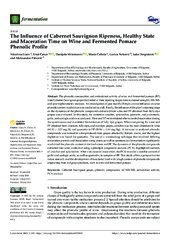Приказ основних података о документу
The Influence of Cabernet Sauvignon Ripeness, Healthy State and Maceration Time on Wine and Fermented Pomace Phenolic Profile
| dc.creator | Lisov, Nikolina | |
| dc.creator | Čakar, Uroš | |
| dc.creator | Milenković, Danijela | |
| dc.creator | Čebela, Maria | |
| dc.creator | Vuković, Gorica | |
| dc.creator | Despotović, Saša | |
| dc.creator | Petrović, Aleksandar | |
| dc.date.accessioned | 2023-09-01T11:31:05Z | |
| dc.date.available | 2023-09-01T11:31:05Z | |
| dc.date.issued | 2023 | |
| dc.identifier.issn | 2311-5637 | |
| dc.identifier.uri | https://www.mdpi.com/2311-5637/9/7/695 | |
| dc.identifier.uri | http://aspace.agrif.bg.ac.rs/handle/123456789/6412 | |
| dc.description.abstract | The phenolic composition and antioxidant activity of wine and fermented pomace (FP) from Cabernet Sauvignon grapes harvested at three ripening stages were evaluated using LC-MS/MS and spectrophotometric analyses. An investigation of grey mold’s (Botrytis cinerea) influence on wine phenolic content modulation was conducted as well. Finally, the influence of the plant’s ripening stage on the dynamics of the phenolic compounds extracted from wine and FP obtained from fully ripe grapes was evaluated. In this study, the content of catechin, epicatechin, quercetin, and p-coumaric, gallic, and syringic acids was analyzed. Wine and FP were obtained after extended maceration during the spontaneous and inoculated fermentation of fully ripe grapes. When comparing the wine and FP obtained from véraison, fully ripe, and overripe grapes, catechin was the most abundant in wine (40.13 ± 3.25 mg/L) and quercetin in FP (10.96 ± 0.14 mg/kg). A decrease in analyzed phenolic compounds was noticed in wine produced from grapes affected by Botrytis cinerea, and the highest depletion was found for quercetin. The use of a winemaking technique that involved differing maceration periods and inoculation using yeasts as well as spontaneous fermentation significantly modulated the phenolic content of derived wines and FP. The dynamics of the phenolic compounds extracted into wine, evaluated using a principal component analysis (PCA), highlighted contents of catechin and epicatechin. After a decrease in maceration, the PCA revealed a notable content of gallic and syringic acids, as well as quercetin, in samples of FP. This study offers a perspective for future research and the development of functional food with a high content of phenolic compounds originating from red grape products, such as wine and fermented pomace. | |
| dc.language | en | |
| dc.relation | info:eu-repo/grantAgreement/MESTD/inst-2020/200116/RS// | |
| dc.relation | info:eu-repo/grantAgreement/MESTD/inst-2020/200161/RS// | |
| dc.relation | info:eu-repo/grantAgreement/MESTD/inst-2020/200017/RS// | |
| dc.relation | info:eu-repo/grantAgreement/MESTD/inst-2020/200116/RS// | |
| dc.rights | openAccess | |
| dc.rights.uri | https://creativecommons.org/licenses/by/4.0/ | |
| dc.source | Fermentation | |
| dc.source | Fermentation | |
| dc.subject | antioxidant activity | |
| dc.subject | Cabernet Sauvignon grape | |
| dc.subject | LC-MS/MS | |
| dc.subject | PCA analysis | |
| dc.subject | phenolic compounds | |
| dc.title | The Influence of Cabernet Sauvignon Ripeness, Healthy State and Maceration Time on Wine and Fermented Pomace Phenolic Profile | |
| dc.type | article | en |
| dc.rights.license | BY | |
| dc.citation.issue | 7 | |
| dc.citation.rank | M22~ | |
| dc.citation.spage | 695 | |
| dc.citation.volume | 9 | |
| dc.identifier.doi | 10.3390/fermentation9070695 | |
| dc.identifier.fulltext | http://aspace.agrif.bg.ac.rs/bitstream/id/24755/The_Influence_of_Cabernet_pub_2023.pdf | |
| dc.type.version | publishedVersion |


